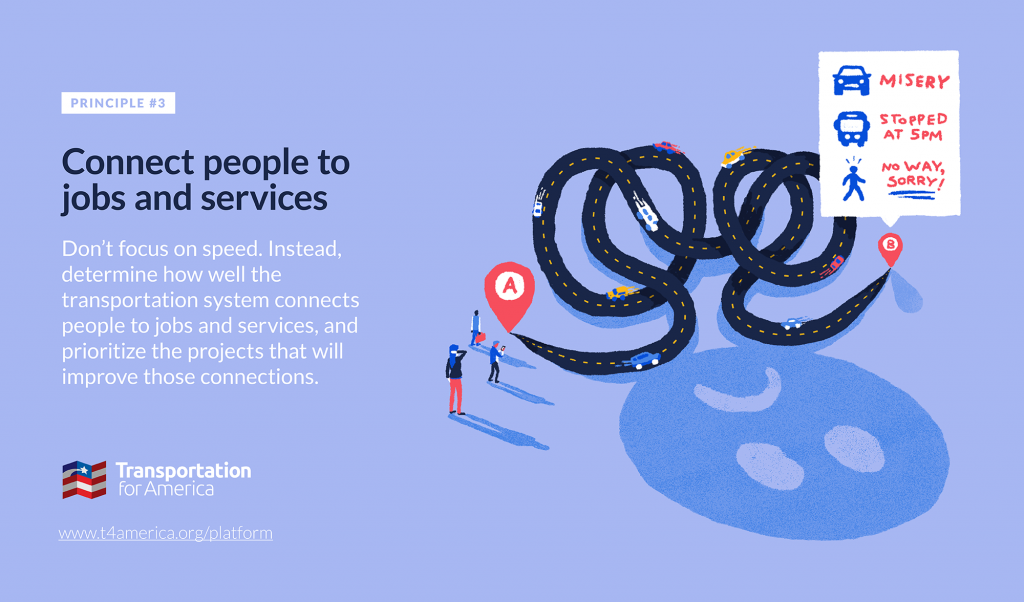It’s time to define transportation success by what actually matters to people: getting where you need to go
For decades, transportation departments have been measuring the wrong thing: vehicle speed. Instead of measuring the speed of a car, we should measure the success of our transportation system by how many jobs and services people can access safely, quickly and affordably.
It’s “Connecting people to jobs and services week” here at Transportation for America. All week we’ll be exploring why improving access should be the goal of the federal transportation program—not vehicle speed. Check out our post from yesterday discussing why it’s time to throw out the traffic measurement level of service, and tune into our Twitter account later today for tweets by renowned transit planner Jarrett Walker.
The goal of our transportation system, and the $40-plus billion in federal dollars we invest each year on it, should be simple: getting people where they need to go. But that’s far from the case.
When you think back about whether or not you had a successful trip, you probably think about if you got from point A to point B and how long that trip took. But state transportation departments don’t measure success that way: they instead measure whether or not your vehicle was moving quickly at some point of the trip. Whether or not you actually arrived isn’t a consideration. And they rarely, if at all, measure whether or not you can access important destinations like jobs and other services.
Using outdated measures like “level of service” that assess how fast traffic moves compared to free flow speeds in the middle of the night, they assume that if the traffic is moving well on a given segment of a road that the trip was high quality and successful. In other words, an hour-long commute at high speed would be considered more successful than a 10-minute commute in a little traffic. Lost entirely in this simplistic proxy are non-car trips—we don’t measure people who walk or bike to work.
But this 20th century technology isn’t a good measure of whether or not people have access to the things they need in their daily lives. We think that destination access, or accessibility, is a much better measure.
Connect people to jobs and services—our third principle
Our third principle is not a new concept. What’s new is that we now have technology that makes it possible to measure success by what actually counts—reaching your destination. A few decades ago, we didn’t know where people were starting their trips from and going to. With a transportation program as we know it that began in the 1950s and 60s, we used simplistic proxies like level of service or vehicle delay or blunt measures of congestion because that was the best we could manage at the time. But now we have reams of data about where trips begin and end, where jobs are located, where people live, and where daily needs are located. With the help of cloud computing and GPS, we can measure every aspect of a trip.
Yet the federal transportation program continues to rely on outdated 1950s metrics that assume a transportation system made up entirely of vehicles (rather than people), where the best measure we can come up with is “did your car go fast or slow for your trip?”
It’s time to actually measure what matters as we decide where and how to invest billions in federal transportation dollars each year.
Think of destination access as the map app you likely have on your phone. When you search for a restaurant or a store, the app can tell you how long it will take to get there by different modes of transportation. And because of the millions of searches performed each day and the location data transmitted, it is now possible for states and local communities to accurately calculate access to employment opportunities, daily errands, public services, and much more. These tools allow cities, states and metropolitan planning organizations (MPOs) to design transportation networks that maximize the ability of people to travel by whatever mode they choose and to better understand how transportation investments interact with land-use policies.
Losing the current dangerous focus on speed and instead measuring accessibility would prioritize efficient travel and a more equitable transportation system, one where low-income communities would have increased access to jobs and services. We can hold agencies accountable to deliver these connections.
Funding should go to projects that will improve these connections, regardless of mode. State DOTs and MPOs should be held accountable by evaluating how well their investments help connect people to destinations—not whether or not they allowed traffic to move a little faster on some segment of road.
Some states are already starting to evaluate projects this way
The Commonwealth of Virginia started using destination access to prioritize transportation projects in 2017. When deciding what new capacity projects to fund, Virginia measures how much access a given project will create and divides that accessibility score by the cost. It’s a transparent, quantitative way to prioritize limited tax-payer dollars.
When we tie funding decisions to measurable outcomes, it creates more faith and buy-in from local communities. Connecting people to jobs and services is something everyone can agree to.
While states like Virginia are voluntarily trying to change the process, to truly experience a sea change, the federal government needs to make improving access a fundamental priority for all transportation dollars.





















Pingback: Transportation For America – To connect people to jobs and services, we need to measure what matters: people
Pingback: Transportation For America – Connecting people to jobs and services week: Hey Congress, we need your help to measure access